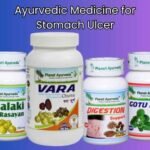Fatty liver, a condition where fat builds up in the liver cells, is becoming increasingly common due to modern lifestyle habits such as poor diet, lack of exercise, and excessive alcohol consumption. While there are various medical treatments available, many people are turning to Ayurveda for natural and holistic remedies. One such potent remedy in Ayurveda for fatty liver is Bhumi Amla (Phyllanthus niruri). This article explores the benefits of Bhumi Amla and how it can help you manage and potentially reverse fatty liver.

Understanding Fatty Liver Disease
Fatty liver disease, also known as hepatic steatosis, is a condition characterized by the accumulation of fat in liver cells. This condition can be broadly categorized into two main types:
1. Alcoholic Fatty Liver Disease (AFLD)
Cause:
- AFLD is directly related to excessive alcohol consumption.
- Alcohol metabolism in the liver produces toxic substances that can damage liver cells, leading to fat accumulation.
Risk Factors:
- High levels of alcohol consumption over a prolonged period.
- Genetic predisposition to alcohol-related liver damage.
- Nutritional deficiencies associated with heavy drinking.
Progression:
- Continued alcohol abuse can lead to more severe liver conditions such as alcoholic hepatitis, fibrosis, cirrhosis, and an increased risk of liver cancer.
2. Non-Alcoholic Fatty Liver Disease (NAFLD)
Cause:
- NAFLD occurs in individuals who consume little to no alcohol.
- It is commonly associated with metabolic syndrome, which includes conditions like obesity, type 2 diabetes, hypertension, and dyslipidemia (high cholesterol or triglycerides).
Risk Factors:
- Obesity: Excess body fat, particularly abdominal fat, increases the risk of NAFLD.
- Insulin Resistance: Often associated with type 2 diabetes and metabolic syndrome, insulin resistance can contribute to fat accumulation in the liver.
- High Cholesterol: Elevated levels of cholesterol and triglycerides in the blood can exacerbate liver fat deposition.
- Genetic Factors: Family history of NAFLD can increase susceptibility.
- Other Conditions: Polycystic ovary syndrome (PCOS), sleep apnea, and hypothyroidism are also linked to NAFLD.
Progression:
- NAFLD can progress to Non-Alcoholic Steatohepatitis (NASH), a more severe form where inflammation and liver cell damage occur.
- Without intervention, NASH can lead to fibrosis (scarring of liver tissue), cirrhosis (severe scarring and liver dysfunction), and hepatocellular carcinoma (liver cancer).
Symptoms and Diagnosis
Symptoms:
- Often asymptomatic in early stages.
- Fatigue and discomfort or pain in the upper right abdomen.
- Advanced stages may show signs of liver dysfunction such as jaundice (yellowing of skin and eyes), swelling in the legs and abdomen, and confusion.
Diagnosis:
- Blood Tests: Elevated liver enzymes (ALT and AST) can indicate liver inflammation.
- Imaging: Ultrasound, CT scan, or MRI can reveal fat deposits in the liver.
- Liver Biopsy: A small sample of liver tissue is examined to assess the extent of fat accumulation and inflammation.
Treatment and Management
Lifestyle Changes:
- Diet: Adopting a healthy diet low in saturated fats and sugars, and rich in fruits, vegetables, and whole grains.
- Exercise: Regular physical activity can help reduce liver fat and improve insulin sensitivity.
- Weight Loss: Gradual weight loss can significantly reduce liver fat and improve liver function.
Medical Treatment:
- Medications: Some medications can help manage conditions associated with NAFLD, such as diabetes and high cholesterol.
- Avoiding Alcohol: Essential for individuals with AFLD and beneficial for those with NAFLD to prevent additional liver damage.
Regular Monitoring:
- Routine check-ups and liver function tests to monitor the progression of the disease.
Prevention
- Limiting alcohol intake.
- Maintaining a healthy weight through a balanced diet and regular exercise.
- Managing underlying health conditions like diabetes and high cholesterol.
- Regular health screenings for early detection and management of liver disease.
Understanding fatty liver disease is crucial for early intervention and preventing progression to more severe liver conditions. Adopting a healthy lifestyle and managing associated risk factors are key to maintaining liver health.
Symptoms of Fatty Liver
Fatty liver disease, whether Alcoholic Fatty Liver Disease (AFLD) or Non-Alcoholic Fatty Liver Disease (NAFLD), can manifest a range of symptoms. Many individuals with fatty liver disease may be asymptomatic, especially in the early stages. However, as the disease progresses, the following symptoms can become more apparent:
- Fatigue
- Persistent tiredness and low energy levels are common, likely due to the liver’s decreased ability to metabolize nutrients and detoxify the body.
- Abdominal Discomfort
- Patients may experience pain or a sense of fullness in the upper right side of the abdomen where the liver is located. This discomfort can range from mild to severe.
- Weight Loss or Loss of Appetite
- Unexplained weight loss and a reduced desire to eat can occur as the disease progresses, often due to the liver’s impaired function and overall impact on the body’s metabolism.
- Weakness
- Generalized weakness and a feeling of being unwell are common as the liver’s role in energy production and toxin removal is compromised.
- Jaundice (in severe cases)
- Yellowing of the skin and eyes, known as jaundice, can develop in advanced stages of fatty liver disease. This occurs when the liver is unable to effectively process bilirubin, a byproduct of red blood cell breakdown.
Other Possible Symptoms
In addition to the primary symptoms listed above, individuals with more advanced liver disease might also experience:
- Swelling (Edema)
- Swelling in the legs, ankles, and feet due to fluid retention.
- Ascites
- Accumulation of fluid in the abdomen, causing noticeable swelling and discomfort.
- Mental Confusion
- Known as hepatic encephalopathy, this can occur when the liver is unable to clear toxins from the blood, leading to confusion, memory problems, and difficulty concentrating.
- Bruising and Bleeding Easily
- Reduced production of clotting factors by the liver can lead to increased bruising and bleeding.
Monitoring and Seeking Medical Attention
Given the often asymptomatic nature of fatty liver disease in its early stages, regular health check-ups and liver function tests are crucial for early detection and management. If you experience any of the above symptoms, especially persistent fatigue, abdominal discomfort, or jaundice, it is important to seek medical advice for proper evaluation and diagnosis.
Bhumi Amla: An Ayurvedic Wonder
Bhumi Amla, scientifically known as Phyllanthus niruri, is a small annual herb renowned in traditional medicine systems, particularly Ayurveda, for its remarkable health benefits. Commonly referred to as “Stonebreaker” or “Chanca Piedra,” this herb has a rich history of use in various cultures for treating a variety of ailments. Here are some key highlights of Bhumi Amla and its benefits:
Key Characteristics
- Botanical Name: Phyllanthus niruri
- Common Names: Stonebreaker, Chanca Piedra, Seed-Under-Leaf
- Family: Phyllanthaceae
- Habitat: Grows in tropical and subtropical regions, often found in coastal areas and riverbanks.
Ayurvedic Significance
In Ayurveda, Bhumi Amla is highly valued for its medicinal properties, particularly in the context of liver health and detoxification. Here are the primary benefits associated with this herb:
1. Liver-Protective Properties
- Hepatoprotective: Bhumi Amla is renowned for its ability to protect the liver from toxins. It is often used to treat liver disorders such as hepatitis, jaundice, and liver cirrhosis.
- Detoxification: It aids in the detoxification process by promoting the elimination of toxins from the liver, thus enhancing overall liver function.
2. Digestive Health
- Digestive Aid: Bhumi Amla helps improve digestion by stimulating the production of digestive enzymes and aiding in the breakdown of food.
- Anti-inflammatory: It has anti-inflammatory properties that can help soothe the digestive tract and reduce symptoms of gastrointestinal disorders.
3. Kidney Health
- Diuretic: The herb acts as a natural diuretic, promoting urine production and helping in the treatment of kidney stones (hence the name “Stonebreaker”).
- Preventive for Kidney Stones: Regular use can help prevent the formation of kidney stones by inhibiting the crystallization of calcium oxalate.
4. Antiviral and Antibacterial Properties
- Immune Boosting: Bhumi Amla possesses antiviral and antibacterial properties, making it effective against various infections, including viral hepatitis.
- Antimicrobial: It helps in fighting off microbial infections, thus supporting overall immune health.
5. Antioxidant Benefits
- Rich in Antioxidants: Bhumi Amla contains potent antioxidants that help in neutralizing free radicals, reducing oxidative stress, and protecting cells from damage.
Usage and Administration
Bhumi Amla can be consumed in various forms, including:
- Powder: Dried and ground into a fine powder, it can be mixed with water or honey.
- Capsules/Tablets: Available as supplements for easier consumption.
- Juice/Extract: Freshly extracted juice or standardized herbal extracts are commonly used.
Safety and Precautions
- Consultation: Always consult with a healthcare provider or an Ayurvedic practitioner before starting any new herbal regimen, especially if you have underlying health conditions or are taking other medications.
- Dosage: Follow recommended dosages as prescribed by a healthcare provider to avoid any potential side effects.
Key Benefits of Bhumi Amla
Bhumi Amla (Phyllanthus niruri), also known as “Stonebreaker” or “Chanca Piedra,” is a potent herb with a wide range of health benefits, particularly for liver health. Here are some of its key benefits:
1. Liver Detoxification
- Toxin Elimination: Bhumi Amla aids in detoxifying the liver by flushing out harmful toxins.
- Oxidative Stress Reduction: It reduces oxidative stress, which is crucial in maintaining healthy liver cells and preventing liver damage.
2. Anti-inflammatory Properties
- Liver Inflammation Reduction: Bhumi Amla has strong anti-inflammatory properties that help reduce inflammation in the liver, which can be beneficial for conditions such as hepatitis and other inflammatory liver diseases.
3. Antioxidant Effects
- Prevents Liver Cell Damage: Rich in antioxidants, Bhumi Amla helps protect liver cells from damage caused by free radicals.
- Supports Overall Liver Health: By neutralizing oxidative stress, it supports overall liver function and health.
4. Antiviral Properties
- Combats Viral Infections: Traditionally used to combat viral infections, Bhumi Amla is particularly effective against Hepatitis B, a viral infection that can lead to severe liver damage.
- Immune Support: Its antiviral properties help strengthen the immune system, making it more effective in fighting off viral pathogens.
5. Improves Digestion
- Enhances Digestive Functions: Bhumi Amla enhances digestive functions by stimulating the production of digestive enzymes.
- Better Fat Metabolism: It helps in better fat metabolism, which prevents the accumulation of fat in the liver, thereby reducing the risk of fatty liver disease.
- Prevents Digestive Disorders: Its digestive benefits extend to preventing various digestive disorders, contributing to overall gastrointestinal health.
How to Use Bhumi Amla for Fatty Liver
Bhumi Amla can be consumed in various forms such as powder, juice, or capsules. Here are a few ways to incorporate it into your daily routine:
Bhumi Amla Powder
- Dosage: Mix 1 teaspoon of Bhumi Amla powder in a glass of warm water. Drink it once or twice a day, preferably on an empty stomach.
- Preparation: You can also mix the powder with honey or add it to smoothies for a more palatable option.
Bhumi Amla Juice
- Dosage: Take 10-20 ml of Bhumi Amla juice once or twice daily.
- Preparation: Dilute the juice in a glass of water and consume it on an empty stomach for best results.
Bhumi Amla Capsules
- Dosage: Follow the recommended dosage on the product label, usually 1-2 capsules a day with water.
- Preparation: Capsules are convenient for those who prefer a no-fuss approach.
Additional Ayurvedic Tips for Managing Fatty Liver
- Dietary Changes: Adopt a balanced diet rich in fruits, vegetables, whole grains, and lean proteins. Avoid processed foods, sugars, and unhealthy fats.
- Regular Exercise: Engage in regular physical activity to maintain a healthy weight and improve liver function.
- Hydration: Drink plenty of water to help flush out toxins from your body.
- Avoid Alcohol: Reduce or eliminate alcohol consumption to prevent further liver damage.
- Herbal Teas: Incorporate herbal teas like dandelion root, milk thistle, and turmeric to support liver health.
Conclusion
Bhumi Amla stands out as a powerful natural remedy in the Ayurvedic tradition for managing fatty liver and promoting overall liver health. By incorporating Bhumi Amla into your routine along with healthy lifestyle changes, you can take significant steps towards a healthier liver. Always consult with a healthcare professional before starting any new supplement regimen to ensure it is appropriate for your individual health needs.
Disclaimer
The information provided in this article is for educational purposes only and should not be considered medical advice. Always consult with a qualified healthcare provider for diagnosis and treatment of any health condition.
Top 20 FAQs About Bhumi Amla for Fatty Liver
1. What is Bhumi Amla?
Bhumi Amla, also known as Phyllanthus niruri or “Stonebreaker,” is an annual herb used in traditional Ayurvedic medicine. It is known for its liver-protective, detoxifying, and anti-inflammatory properties.
2. How does Bhumi Amla help with fatty liver?
Bhumi Amla helps with fatty liver by detoxifying the liver, reducing inflammation, and preventing oxidative stress. Its active compounds support liver function and improve fat metabolism, preventing fat accumulation.
3. Can Bhumi Amla cure fatty liver disease?
While Bhumi Amla can significantly aid in managing and improving fatty liver conditions, it is not a cure. It should be used as part of a comprehensive treatment plan that includes dietary changes, exercise, and medical supervision.
4. How should Bhumi Amla be consumed for fatty liver?
Bhumi Amla can be consumed in powder, juice, or capsule form. It is typically taken on an empty stomach for maximum absorption. Always follow the recommended dosage on the product label or as advised by a healthcare professional.
5. Are there any side effects of Bhumi Amla?
Bhumi Amla is generally safe for most people when taken in recommended doses. However, excessive consumption may lead to gastrointestinal discomfort, such as nausea or diarrhea. Always consult with a healthcare provider before starting any new supplement.
6. Can Bhumi Amla be taken with other medications?
It is advisable to consult with a healthcare provider before combining Bhumi Amla with other medications, especially those for liver conditions, as it may interact with certain drugs.
7. How long does it take to see results from Bhumi Amla for fatty liver?
The time to see results can vary depending on the severity of the condition and individual response. Some people may notice improvements in a few weeks, while others might take a few months.
8. Can Bhumi Amla be used for alcoholic fatty liver disease?
Yes, Bhumi Amla can help manage both alcoholic and non-alcoholic fatty liver diseases by supporting liver detoxification and reducing inflammation.
9. Is Bhumi Amla safe for long-term use?
Bhumi Amla is considered safe for long-term use when taken in appropriate doses. However, periodic consultation with a healthcare provider is recommended to monitor liver health and overall well-being.
10. Can pregnant or breastfeeding women take Bhumi Amla?
Pregnant or breastfeeding women should consult with a healthcare provider before taking Bhumi Amla or any other supplements to ensure safety for both mother and child.
11. What is the best time of day to take Bhumi Amla?
Bhumi Amla is best taken on an empty stomach, either in the morning or before meals, to maximize its absorption and effectiveness.
12. Can Bhumi Amla be used for other liver conditions?
Yes, Bhumi Amla is beneficial for various liver conditions, including hepatitis, cirrhosis, and jaundice, due to its hepatoprotective and detoxifying properties.
13. Where can I buy Bhumi Amla?
Bhumi Amla is available in health food stores, Ayurvedic shops, and online retailers. Ensure you purchase from reputable sources to guarantee product quality and authenticity.
14. Can Bhumi Amla help with weight loss?
Bhumi Amla may aid in weight loss indirectly by improving liver function and enhancing fat metabolism. However, it should be combined with a healthy diet and regular exercise for best results.
15. Is Bhumi Amla effective for children with liver issues?
While Bhumi Amla may be beneficial for children, it is essential to consult with a pediatrician or a healthcare provider to determine the appropriate dosage and ensure it is safe for the child’s specific condition.
16. Can Bhumi Amla be taken with other herbal supplements?
Bhumi Amla can generally be taken with other herbal supplements. However, it is advisable to consult with a healthcare provider to avoid potential interactions and ensure a balanced approach.
17. Does Bhumi Amla have any nutritional benefits?
Yes, Bhumi Amla is rich in antioxidants, vitamins, and minerals that support overall health and well-being, including immune function and digestive health.
18. Can Bhumi Amla improve liver enzyme levels?
Bhumi Amla may help improve liver enzyme levels by reducing liver inflammation and supporting detoxification processes. Regular monitoring and medical supervision are recommended to track progress.
19. How should Bhumi Amla be stored?
Store Bhumi Amla in a cool, dry place away from direct sunlight. Ensure the container is tightly sealed to preserve its potency and prevent contamination.
20. Are there any dietary recommendations to follow while taking Bhumi Amla for fatty liver?
Yes, it is recommended to follow a liver-friendly diet rich in fruits, vegetables, whole grains, and lean proteins. Avoid processed foods, sugars, unhealthy fats, and alcohol to support liver health and enhance the benefits of Bhumi Amla.
Related posts:
 Ayurvedic Medicine for Stomach Ulcer: A Natural Approach to Healing
Ayurvedic Medicine for Stomach Ulcer: A Natural Approach to Healing
 Ayurvedic Medicine for Stomach Health: Natural Remedies for Digestive Wellness
Ayurvedic Medicine for Stomach Health: Natural Remedies for Digestive Wellness
 7 Reasons Why You Must Add Turmeric to Your Diet for Good Gut Health
7 Reasons Why You Must Add Turmeric to Your Diet for Good Gut Health
 Want to Reduce Belly Fat? Practice These 5 Exercises at Home in Just 10 Minutes Daily
Want to Reduce Belly Fat? Practice These 5 Exercises at Home in Just 10 Minutes Daily
 5 Unexpected Benefits of Consuming One Spoon of Ghee on an Empty Stomach in the Morning
5 Unexpected Benefits of Consuming One Spoon of Ghee on an Empty Stomach in the Morning
 Natural Sleep: The Ayurvedic Approach
Natural Sleep: The Ayurvedic Approach
 Feeling Lazy? 5 Healthy Herbal Teas to Help You Energize Your Mornings
Feeling Lazy? 5 Healthy Herbal Teas to Help You Energize Your Mornings
 Weight Loss: 5 Household Chores That Can Actually Help Burn Calories and Melt Fat at Home
Weight Loss: 5 Household Chores That Can Actually Help Burn Calories and Melt Fat at Home
 The Secrets of Apple Cider Vinegar: Your Hair’s New Best Friend
The Secrets of Apple Cider Vinegar: Your Hair’s New Best Friend




